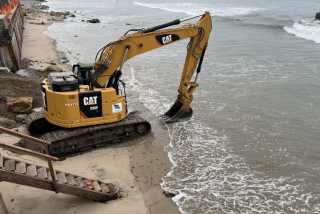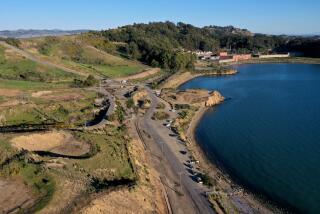Public Land Is Public Land : Open beachfront must not only be preserved but kept accessible, too
- Share via
Residents are fond of the California coastline, and they want to protect it. Of all the lands in public ownership, the vulnerable shoreline has a unique power to rally residents to fight any threat--either to the beachfront or to public access. In recent days, that point was brought home in three different locales along the Southern California shoreline off Pacific Coast Highway. It ought to be very simple but sometimes isn’t: Public land is public land.
At Will Rogers State Beach near Santa Monica, the popular Gladstone’s-4-Fish restaurant was cited in a California Coastal Commission staff report, which said the restaurant violated state Coastal Act provisions by illegally expanding its dining area. It’s another troubling matter of private use of public coastal land. The restaurant leases state beach property administered by Los Angeles County.
Further south, in Newport Beach, the City Council rejected a $60-million expansion project at the exclusive Balboa Bay Club. Although on public bay-front land, the club is private. For the last 42 years, it has operated under a lease from the city. The lease doesn’t expire until 2011, but there is understandably strong public sentiment against allowing the club to do anything new that might harm the environment or block the view or access.
And residents in the gated coastal colony at Capistrano Beach find themselves under new public scrutiny. The $7 million worth of road and utility improvements they are considering opened the question of public accessibility. Residents wonder if the Dana Point City Council or the Coastal Commission will open to the public a private, 1.6-mile beachfront road that provides residents access to their homes. As it is, the governing Capistrano Bay District, supported by residents’ fees and property taxes, keeps the road closed to non-residents. But good questions are coming up about the legality of a public agency denying beach access to the public.
Cozy leases of public coastal areas to private interests may have been more acceptable in the 1940s and ‘50s, when there was less environmental awareness and demand for coastal facilities. No more. The increasing confrontations along the coastline serve warning to public officials entrusted with protecting the coastline that a lax attitude among the public no longer exists. It is not enough only to preserve the public’s beachfront. It must be kept accessible, too.
More to Read
Sign up for Essential California
The most important California stories and recommendations in your inbox every morning.
You may occasionally receive promotional content from the Los Angeles Times.










